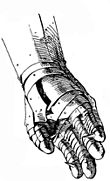Combat glove
Combat gloves are gloves made of various materials that are designed and constructed to be used as a striking weapon .
Combat glove types
Today all gloves used in armies around the world are commonly referred to as combat gloves. This designation refers more to the fact that they are worn in combat than to use as a weapon . To be distinguished from this are the combat gloves , which are considered to be a striking weapon and make up the actual type of combat glove, and the gauntlets , which are designed as protective weapons . The following types of combat gloves were primarily designed as weapons:
Quartz sand glove
Quartz sand gloves , also impact-reinforcing gloves, are gloves that are equipped with cavities on the back of the hand and in the area of the knuckles, which are filled with fine quartz sand or lead dust. Some versions of these gloves are made with an additional layer of Kevlar that protects them against being cut through or punctured. The sand filling makes these gloves look like brass knuckles. As a result, the blows performed with them are significantly stronger than blows with the bare fist. Furthermore, the gloves protect the hands from cuts and stab injuries during use. In addition, they protect the hands from injuries that can be caused by one's own blows.
Iron glove
The iron glove is a weapon armored gauntlet . It was made in Italian workshops around the end of the 16th century . With these metal gloves, the top and the inside of the hand were completely armored. The inside of the hand was armored with molded steel plates, which ensured the hand had complete freedom of movement. Sharp, slightly curved spines that could be used as a weapon are attached to the tips of the ring and index finger and the thumb. If the sword was lost in combat, or if there was close combat, these spikes were used to hit the face or lightly or uncovered parts of the body. This type of glove did not catch on and disappeared again after a short time.
Cestus
The Cestus is a type of combat glove that was developed for the sport of pankration . It consists of leather straps ( Greek himantes ) that are wrapped around the hands just below the ankles. With its complicated arrangement of wide and narrow leather straps, it looks almost like a glove that reaches to the elbow when ready to fight. Later, metal thorns were placed on the ankle ligaments to increase the impact. The Romans expanded the striking action of the Cestus even more, adding blades. This Roman type of cestus was called "myrmax" and was used in gladiator fights . The Greeks developed another species they called "sphairai". These were also equipped with blades.
literature
- Wendelin Boeheim: Handbook of the armory . Reprint d. Ed. Leipzig 1890. Fourier Verlag, Wiesbaden 1985, ISBN 978-3-201-00257-8 , pp. 78-86
- George Cameron Stone, Donald J. LaRocca: A Glossary of the Construction, Decoration and Use of Arms and Armor: in All Countries and in All Times . Courier Dover Publications, 1999, ISBN 978-0-486-40726-5 , pp. 244-246
- Ulrich Sinn: Ancient Olympia - gods, games and art . Verlag CH Beck, Munich 2004, ISBN 3-406-51558-4 .
Web links
- Notice of assessment (PDF; 87 kB) from the BKA
- Website of the German Federation of Pankration Athlima
Individual evidence
- ↑ Plutonia Plarre: Quartz sand glove with the police: A tangible scandal. In: taz . December 1, 2008, accessed November 18, 2016 .


